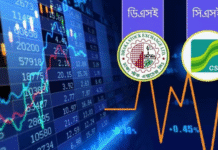
Economic recovery following the coronavirus lockdown will require massive government intervention and tons of money. The Bangladesh government has already introduced a series of measures to contain and mitigate the initial assault by the virus. On the economic front, it has unveiled 18 stimulus packages amounting to Tk 95,619 crore to pull various sectors of the economy out of the coronavirus-induced slump and protect the poor and newly unemployed. As the economy reopens in earnest, factories will need loans, businesses will ask for contracts, and the hungry and the unemployed will seek food, healthcare, and jobs. The total needs will exceed Tk 100,000 crore.
Fortunately, the government has the ability to generate the resources needed for the stimulus package. It can use the various tools at its disposal, including tax and spending, loans and guarantees, monetary instruments, and foreign exchange operations. Since the pandemic has created both demand and supply shocks, governments everywhere have resorted to a policy mix that includes fiscal, monetary and sectoral measures. As Fahmida Khatun wrote in an earlier oped in this daily, Bangladesh government and its agencies must “use all types of monetary policy tools that they have at their disposal, such as lowering interest rates and quantitative easing to pump money into the financial system.” As expected, the lion’s share of the funds will come from borrowing.
The reason is, while Bangladesh Bank has lowered interest rates (Repo) and reserve requirements, announced new financing facilities, relaxed capital buffers, and other countercyclical measures, lowering interest rates to encourage businesses to borrow can work only if consumer demand for shuttered business picks up again. With so many of the garment employees either out of work or coping with reduced wages, it cannot be a surprise that closed businesses (such as transportation sector, retailers, supermarkets, and booksellers for example) will not expect a surge in demand on the first day they reopen. Similarly, restaurant workers, rickshaw pullers, or many middle-class employees have no incomes, and this will undercut their ability to spend. In addition, remittances from abroad have taken a hit, and all of these add up to a demand shock.
Economists at the Massachusetts Institute of Technology (MIT) and the University of Chicago argue that during the current economic crisis induced by the pandemic, lack of demand could trigger viral recessions. This idea is explored in a new working paper by Veronica Guerrieri of the University of Chicago, Guido Lorenzoni of Northwestern University, Ludwig Straub of Harvard University and Iván Werning of MIT. “If some sectors of the economy shut down entirely, affected workers will curtail their spending dramatically. Spending by other workers could make up for the shortfall—only if the goods and services that can still be produced are substitutes for those that cannot. The abrupt drop in consumers’ spending on plane tickets or hotel bookings is unlikely to be offset by more purchases of teleworking software instead, for instance. In such a situation, the economy experiences a “Keynesian supply shock”, where demand falls by more than supply.”
The point is, the government will have to pump money into the economy, both by spending more on feeding the vulnerable groups and building healthcare infrastructure. Borrowing is no longer considered to be a sign of bad governance and often advocated to act as a counter-cyclical force during a recession. While borrowing (both domestic and external) has been at the receiving end of the public’s ire for short periods of time, particularly during the financial crisis of 2007-2010 when some European countries faced high domestic and foreign debt, the current economic slowdown has forced the hands of many governments to support printing money to stimulate the economy.
Admittedly, the national debt of any country is a major concern for policymakers. Loans have to be paid back, even when the borrowing happens from domestic sources. While deficit financing or debt leveraging has always been a controversial tool in the arsenal of development finance, in a moment of crisis, printing money is a necessity and the real cost of deficit financing is less than the nominal, since inflation and time discounts ease the financial burden on the nation.
Glenn Hubbard, a professor of finance and economics at Columbia University, and former Chairman of the Council of Economic Advisers in the USA, argues strongly for printing money during a crisis. “I think the Treasury did the right thing. I think the Fed is doing largely the right thing,” he said. “There shouldn’t be an ongoing dance of borrowing money and printing money. This isn’t the lesson to learn from this episode.”
In other words, borrowing money by selling treasury bonds to the central bank, and “printing money” is essentially the same thing. As another economist, Professor McCulley of Georgetown University put it more bluntly, “How do we pay for it? We print the damn money.”
If the government prints more money, there are risks. First of all, the government might not be able to pay it back. This will happen if the debt burden gets too high. According to the “Joint World Bank-IMF Debt Sustainability Analysis” released in September 2019, the overall risk of debt distress for Bangladesh is low. Public debt in Bangladesh stood at USD 91 billion in the fiscal year ending in 2018, around 34 percent of GDP.
The other risk is inflation. At some point, the economy will recover, and BB needs to keep an eye on the price level and keep it below the six percent target. In future, inflation could be low for a long time, but it also could rise. There is a lot of pent-up demand in our economy—the capacity to supply goods and services has been hurt, and its coincidence with a collapse in supply might lead people to expect rocketing prices. The saving grace is that in some circumstances, the drop in demand induced by a supply shock may be larger than the decline in supply—a source of deflationary, rather than inflationary, pressure.
Japan’s central bank has been buying huge chunks of the government’s bonds—effectively financing the central government of the world’s third-largest economy for years—without triggering the kind of inflation that traditional economic views would expect.
However, some words of caution are required. First, as mentioned above, inflation might get out of control. Secondly, the debt to GDP ratio could spiral towards the danger level—90 percent of GDP. Higher debt ratio and inflation will trigger macroeconomic instability and throw the exchange rate out of kilter.
Thirdly, in many of the developed countries including the USA, easy money has led to misallocation, inefficiency, and lack of oversight. In the USA, the USD 3 trillion stimulus will be financed by “monetisation of debt”. And, given this ease of access, it has led to some well-publicised cases of abuse, waste and fraud. Small business loans were gobbled up by big companies, leaving very little for the needy ones.
Similarly, in Bangladesh, how much of the Tk 5,000 crore given to RMG owners will actually be given to the workers? Besides, BB has also taken measures to delay non-performing loan classification and this has already raised some eyebrows.
On the brighter side, Bangladesh, along with other developing countries, has sought the International Monetary Fund’s (IMF) help. A Special Drawing Rights (SDR) allocation is one way the IMF could respond. The last SDR allocation was in 2009, in response to the global financial crisis. However, in such an allocation, all members receive SDRs based on their IMF quotas, so a large share of the money goes to developed countries like the United States, leaving little for stressed emerging markets. However, it has been suggested that as an alternative, IMF emergency lending capacity, if invoked, could allow the Fund to allocate it to those most in need.
Dr Abdullah Shibli is an economist and works in information technology. He is Senior Research Fellow, International Sustainable Development Institute (ISDI), a think-tank in Boston, USA.









